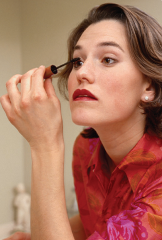About FDA
FDA Basics: How FDA Evaluates Regulated Products: Cosmetics
The Food and Drug Administration’s Strategic Action Plan for Risk Communication is an initiative to tell consumers how the agency makes decisions on the safety and effectiveness of FDA-regulated products. This is the first in a series of articles about the data and methods—and their limitations—that FDA uses to determine whether products are safe for consumers to use.
Here's a look at how FDA's Office of Cosmetics and Colors evaluates the safety of cosmetics.
The Regulation of Cosmetics

Under the Federal Food, Drug, and Cosmetic Act, cosmetic products and ingredients do not require FDA approval before they go on the market. The exception is color additives (other than those used in most hair dyes). Companies and individuals who market cosmetics have the legal responsibility to ensure the safety of their products.
To learn more, see FDA Authority Over Cosmetics.
Safety Data and Its Limitations
FDA monitors the safety of cosmetic products that are being marketed and acts on products that are established to be harmful to consumers when used as intended. The agency has a number of ways to monitor these products but often the available safety information is limited:
- Voluntary Cosmetic Registration Program: FDA encourages cosmetic firms to report product formulations through the VCRP. The VCRP database provides important information on these cosmetics. However, the companies are not legally required to tell FDA about their products and safety data.
- Inspections: FDA can inspect manufacturing facilities to determine if proper controls and practices are being followed. FDA also works with U.S. Customs and Border Protection to examine imported cosmetics. But because resources are limited, only a few establishments are inspected each year, and just a fraction of imports are physically examined.
- Surveys of products: FDA periodically buys cosmetics and analyzes them, especially if aware of a potential problem. The information obtained can be used to alert consumers, support regulatory actions, or issue guidance for industry. FDA does not have the resources to sample and analyze all cosmetics on the market.
- Cosmetic Ingredient Review (CIR) expert panel: The CIR is an independent, industry-funded panel of medical and scientific experts that meets quarterly to assess the safety of cosmetic ingredients based on data in the published literature as well as some that is voluntarily provided by the cosmetic industry. The industry data may or may not be complete. FDA takes the results of CIR reviews into consideration when evaluating safety, but the results of FDA safety assessments may differ from those of CIR.
- Reports from consumers and health care providers: Because the law does not require that bad reactions to cosmetics be reported to FDA, we may be unaware of problems. That's why FDA is trying to increase consumer awareness about the importance of reporting cosmetic-related problems. (See Bad Reaction to Cosmetics? Tell FDA.) If you experience a bad reaction to a cosmetic, please contact FDA’s problem-reporting program, MedWatch, on the Web or at 1-800-332-1088; or contact the consumer complaint coordinator in your area.
FDA’s Own Research
FDA conducts research on cosmetic products and ingredients to address safety concerns or to provide information to support regulatory actions or guidance. For example, the agency has conducted research on skin absorption of cosmetic ingredients, tattoo inks, and potential contaminants.
In considering the safety of a product, a number of factors are considered, such as:
- whether a cosmetic is likely to be inhaled, swallowed, or absorbed through the skin
- how often it is generally used
- how long it stays in contact with the body (for example, leave-on or wash-off)
- whether some people, such as children, the elderly, or people with compromised immune systems, might be more vulnerable than others
What Can FDA Do if a Cosmetic Is Not Safe?
To prevent further shipment of a cosmetic that does not comply with the law, FDA may
- ask a federal court to issue an injunction
- request that U.S. marshals seize the products
- initiate criminal action
- refuse entry of an imported cosmetic
- request that a company recall a product
FDA cannot require recalls of cosmetics, but works with companies to make sure their recalls are effective.
 Show all related FDA Basics Questions
Show all related FDA Basics Questions
- FDA Webinar on Tattoos and Permanent Makeup
- Does FDA approve the color additives used in cosmetics? If so, how does FDA determine their safety?
- How FDA Evaluates Regulated Products: Cosmetics
- FDA Basics Video: Ensuring That Cosmetics Used in the United States Are Safe
- What should I do if I have a serious reaction (side effect) to a cosmetic product?
- FDA Basics Webinar on Reporting Adverse Events Related to Cosmetics
- Are henna tattoos safe?
- Is there lead in lipstick?
- Are all personal care products regulated as cosmetics?
- Are cosmetics approved by FDA?
How helpful was this information?








